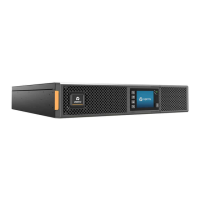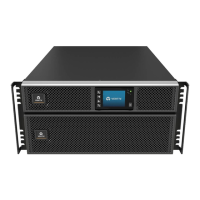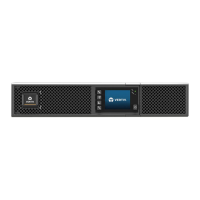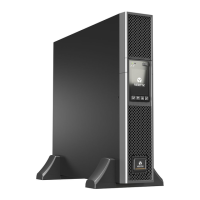2.6 Major Internal Components and Operating Principle
Figure 2.13 below, shows the UPS operating principle. Figure 2.13 below, describes the function of the major components in
the UPS.
NOTE: Figure 2.13 below, is one example of basic operation. The actual I/O connections for the various models may be
divided into different types. See Hardwired Input/Output Connections on page23.
Figure 2.13 Basic Operating Principle Diagram
Item Component Operation/Function
1
Transient Voltage
Surge Suppression
(TVSS) and
EMI/RFI Filters
Provide surge protection. Filter electromagnetic interference (EMI) and radio frequency interference (RFI). Minimize
surges or interference present in the utility power and protect devices connected on the same branch as the UPS.
2 Battery Charger
Regulates input AC power to continuously float-charge the batteries. Batteries are charged when the UPS is plugged in,
even when not powered-on.
3 Batteries
Valve-regulated, non-spillable, lead-acid batteries.
NOTE: To maintain battery design life, operate the UPS in an ambient temperature of 59 °F to 77 °F (15 °C to 25
°C).
4
DC-to-DC
Converter
Raises the DC voltage from the battery to the optimum operating voltage for the inverter. This allows the inverter to
operate continuously at its optimum efficiency and voltage, thus increasing reliability
5
Rectifier/Power
Factor Correction
(PFC) Circuit
In normal operation, converts utility AC power to regulated DC power for use by the inverter while ensuring that the
wave shape of the input current used by the UPS is near ideal. Extracting this sine-wave input current ensures efficient
use of utility power and reduces reflected harmonic distortion making cleaner power available to devices that are not
protected by the UPS.
6 Inverter
In normal operation, inverts the DC output of the PFC circuit into precise, regulated sine-wave AC power. When utility
power fails, the inverter receives DC power from the DC-to-DC converter. In either operating mode, the UPS inverter
remains on-line, generating clean, precise, regulated AC-output power.
7 Internal Bypass
In the unlikely event of UPS failure such as overload or over temperature, automatically transfers the connected load to
bypass. To manually transfer the connected load from inverter to bypass, see Transferring from Normal to Bypass
Mode on page34 .
8 Outlet group Output receptacles.
Table 2.2 Major Components
2 Product Description Proprietary and Confidential ©2024 Vertiv Group Corp. 13
Vertiv™ Liebert® GXT5 UPS Installer/User Guide

